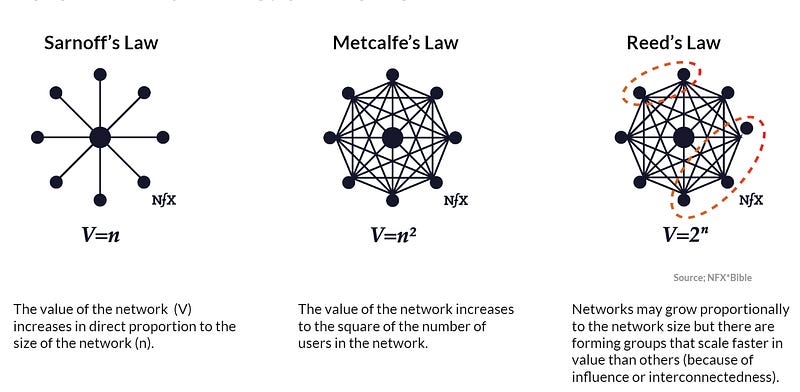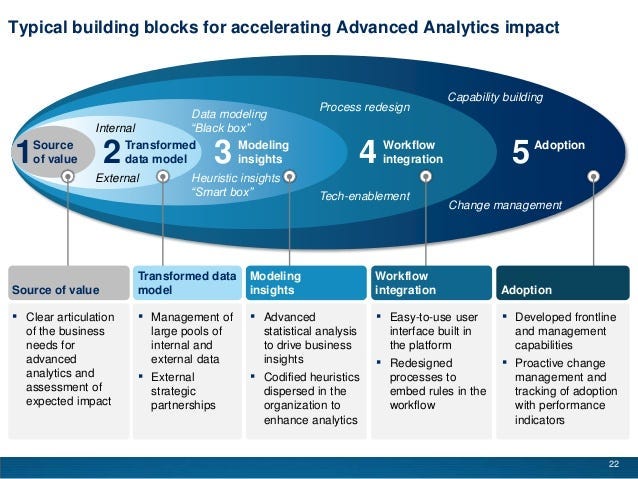Corporate data science — a working mind
Harness human signal generation for accurate business intelligence
Harness human signal generation for accurate business intelligence
Here is the take away of this article: Management nautrually conforms to Sarnoff’s law when they should activly instrument Reed’s law driving internal data science.
The predominant form of communication for top-level management today is a point to point model. Often illustrated in Metcalf’s first step (not shown here). This has surprising consequences for corporate communication and its emergent properties. You may think Slack, Teams, Chat, and a host of other tools are the answer. It is not, as I will explain.
An evolutionary step for management has been Sarnoff’s law. All nodes are feeding the center while the center broadcasts to the nodes. You might see this as quarterly reports and all-hands meetings — a real revolution of the last century.
The behavior, size, and complexity of the resulting communication networks as described by Metcalf’s law, in which each point is a node connected to many nodes. For example, in the most straightforward interface, two nodes (A and B) that communicate to form one edge (A-B). As more nodes are added, complexity increases depending on how the nodes are connected.) This yields many point to point communications but assigns no value to groups or the lines inherent between them.
A new revolution has been developing outside of these laws. Data science and deep learning give meaning to the lines in these laws. The inherent connections have a value higher than the nodes themselves, with technology unlocking that value in near realtime. This gives rise to Reed’s law and the red circles that form from groups. Value in groups and lines captured by data science.
Data scientists have been historically outward-facing. They are working on problems for customers such as system performance, delivery optimization, inventory control, and the ever-favorite fraud detection. These are massive teams in a customer-focused world looking for revenue generation. Think of Palantir. A company with more access to data than possibly anyone on the planet mainly built to help Governments. What Palantir got right about data science is this; you need the data.
Who works for a company doing “internal” data science?
Companies are people. People are nodes. Value is found in the lines of connection. The irony is this; the data is there for the taking. Information flows in and among these groups, as Reed’s law illustrates. For the few people who know they work for companies using internal data science, this is old news. For the rest of the world, it’s a revolution waiting to happen. What’s holding you back from unlocking this potential?
Tools are not the solution; they are a component of it.
Data science must be unlocked to achieve success at every level in today’s competitive just in time world. It’s not just about the information; it’s about creating value from the data and making it actionable. The old model of chaining information through a Sarnoff’s model is dead. Layers of management leading to the top are obsolete. A new model of creating value in companies must come from empowering Reed’s law. Data produced by the organization for the organization allowing executives to lead.
Why is this important, and how will it change the way you lead? First, it will remove the bottlenecks of communication. No more hub and spoke lockups. It will open operational efficiencies to more significant input to strategic decisions. It’s a well-known fact that when employees feel they don’t contribute, they leave or underperform.
We need to make better signals out of these nodes and lines. Many advocate this approach. Here are a few examples;
Mckinsey & Company
But let’s get real. I opened this up by giving you the problem domain. It’s a management model that is old and stale. Fundamentally wrong for any data-driven company. You can sugar coat it all you like, but not addressing your internal operations with the same skills used to treat your customer is short-sighted and potentially dangerous. That is why I am directing this post at management and the “C-Suite” executives and focusing on communication not pure data science.
You must create roles that define internal data streams! Some of your best market research and knowledge is locked in your employee nodes and lines of communication. Stop buying tools just to create data tidepools. Use data science experts to create rivers and streams that feed a proper data lake, which is your most valuable corporate asset. Stop seeing internal improvements as cost centers and find out what real data-driven companies already know. There is profit in the information.
Management is not about rolling up your sleeves and parading around the shop floor. The observer effect negates the value of this approach. The observer effect is the theory that the mere observation of a phenomenon inevitably changes that phenomenon. We all know that employees always tailor responses when management is around. Building new data sources out of these talent pools will help reduce or eliminate the observer effect.
Does a quarterly report or quarterly business review capture how your company interacts with customers on a daily basis? Are you verifying data you have or responding to events as they happen?
Information should drive management. Designed to verify facts as leaders tour a plant, office or customer visit. Systems like this create a natural check and balance out of your data. Validating customer interactions and driving solutions. Stop being reactive and post event-driven. Create a “Check and Balance” model for internal operations, leverages data science and this new method of analysis.
Customers data signals should be matched to operational data signals modeling company performance.
Examples of data science application:
Is the service department dealing with similar or growing problems?
Are we seeing internal service tickets lining up with customer complaints volumes?
Is a customer product defect already being discussed or worked on in your engineering team?
Do we have an internal product design issue we suspect might be the installed base?
In other words, you can verify if something is already in play or do you have to guide the company into a solution. Eliminate hub and spoke type manager to manager communication. Unlock the best of both worlds.
You may just unlock signals to potential customer issues before a customer knows. You will also be creating the foundation for better dashboards later on down the road. But that’s for another post.
Reed’s law draws red lines around groups. If you understand those redlines are associated with activities in your company, then you can develop signals for them. Signals must be designed to check and verify elements of information or boundaries to be established. Used against external data, you can draw out new correlations and insights. Establish redlines and connections so you explicitly know when you cross them. The future of your company and the power of information already exists. You just have to empower data science to visualize it.




